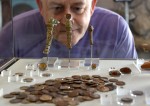 Two hoards of Iron Age and Roman coins and jewelry discovered in 2012 and 2014 have gone on display for the first time at the Museum of Liverpool. The Museum of Liverpool and the Congleton Museum secured a £65,400 ($93,400) grant from the Heritage Lottery Fund to acquire both hoards and create an exhibition that can tour the area. That exhibition is now up and running and will be shared between the institutions. It moves to the Congleton Museum in July.
Two hoards of Iron Age and Roman coins and jewelry discovered in 2012 and 2014 have gone on display for the first time at the Museum of Liverpool. The Museum of Liverpool and the Congleton Museum secured a £65,400 ($93,400) grant from the Heritage Lottery Fund to acquire both hoards and create an exhibition that can tour the area. That exhibition is now up and running and will be shared between the institutions. It moves to the Congleton Museum in July.
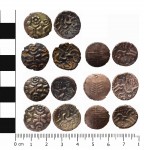 The Malpas Hoard was discovered at a metal detecting rally on January 9th, 2014, near Malpas, Cheshire. It’s a group of 35 coins, seven Iron Age British gold coins and 28 early Roman coins. The British coins are gold staters struck between 20 and 50 A.D., three of them of the western regional series inscribed “EISV” and four of the northeastern series inscribed “VEP CORF.” This is remarkable because western coins circulated in Gloucestershire and surrounding counties where the Dobunni tribe lived, significantly to the south of Malpas, while northeastern coins circulated in Corieltavi territory of Lincolnshire and Leicestershire, significantly to the east of Malpas. Individual coins in the series have been found in the northwest, but this is the first hoard. It’s also very unusual to find a split of regions in a single hoard.
The Malpas Hoard was discovered at a metal detecting rally on January 9th, 2014, near Malpas, Cheshire. It’s a group of 35 coins, seven Iron Age British gold coins and 28 early Roman coins. The British coins are gold staters struck between 20 and 50 A.D., three of them of the western regional series inscribed “EISV” and four of the northeastern series inscribed “VEP CORF.” This is remarkable because western coins circulated in Gloucestershire and surrounding counties where the Dobunni tribe lived, significantly to the south of Malpas, while northeastern coins circulated in Corieltavi territory of Lincolnshire and Leicestershire, significantly to the east of Malpas. Individual coins in the series have been found in the northwest, but this is the first hoard. It’s also very unusual to find a split of regions in a single hoard.
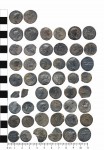 The Roman coins are silver denarii, most of them from the Republican period. The earliest was struck in 134 B.C. by the moneyer Augurinus in Rome. The most recent were struck in the reign of Tiberius Caesar (14-37 A.D.). This group is typical of the kind of money introduced to Britain from the time of the Roman conquest in 43 A.D. Experts believe the hoard was buried shortly thereafter, in the 40s or 50s A.D., because the Tiberius coins are in very good condition and show few signs of wear so they can’t have been in circulation long.
The Roman coins are silver denarii, most of them from the Republican period. The earliest was struck in 134 B.C. by the moneyer Augurinus in Rome. The most recent were struck in the reign of Tiberius Caesar (14-37 A.D.). This group is typical of the kind of money introduced to Britain from the time of the Roman conquest in 43 A.D. Experts believe the hoard was buried shortly thereafter, in the 40s or 50s A.D., because the Tiberius coins are in very good condition and show few signs of wear so they can’t have been in circulation long.
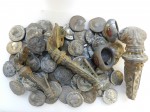 The Knutsford Hoard was first discovered by a metal detectorist Alan Bates in May of 2012. He and archaeologists from the National Museums Liverpool and Cheshire Archaeological Advisory Service returned to the find site in June and removed a soil block containing many more coins for excavation in the lab. The final tally is 101 silver denarii, two sestertii, three gilded silver trumpet brooches and two silver finger rings. There was also a group of pottery fragments, including 21 from an orange-ware vessel. The earliest coin is a denarius issued by Mark Antony around 32-31 B.C.; the latest a denarius from the reign of Commodus dating to 190-191 A.D. That suggest the hoard was buried in the late second century.
The Knutsford Hoard was first discovered by a metal detectorist Alan Bates in May of 2012. He and archaeologists from the National Museums Liverpool and Cheshire Archaeological Advisory Service returned to the find site in June and removed a soil block containing many more coins for excavation in the lab. The final tally is 101 silver denarii, two sestertii, three gilded silver trumpet brooches and two silver finger rings. There was also a group of pottery fragments, including 21 from an orange-ware vessel. The earliest coin is a denarius issued by Mark Antony around 32-31 B.C.; the latest a denarius from the reign of Commodus dating to 190-191 A.D. That suggest the hoard was buried in the late second century.
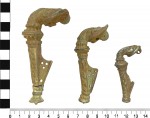 Trumpet brooches, so named because their open ends and tubes look like trumpets, were a popular style in the 2nd century and appear to be associated with the Roman army. These are heavy, expensive examples, made in a mould and decorated with British-style scrolls and curvilinear designs. They are parcel-gilt: the background of the scrollwork is gilded while the scrolls themselves are left in silver.
Trumpet brooches, so named because their open ends and tubes look like trumpets, were a popular style in the 2nd century and appear to be associated with the Roman army. These are heavy, expensive examples, made in a mould and decorated with British-style scrolls and curvilinear designs. They are parcel-gilt: the background of the scrollwork is gilded while the scrolls themselves are left in silver.
 The finger rings are silver with intaglio carnelian stones. One of the carnelians has been engraved with a winged figure, possibly Mercury or Victory, facing left with one arm raised. The carving on the other stone is no longer visible. It appears to have been file away. They’re very small, just 25 and 26 millimeters wife, so they may have been women’s jewelry. On the other hand, intaglio rings were often used to stamp wax seals which was more of a man’s game at the time, so it’s possibly they might have been intended for a man to wear on his pinky.
The finger rings are silver with intaglio carnelian stones. One of the carnelians has been engraved with a winged figure, possibly Mercury or Victory, facing left with one arm raised. The carving on the other stone is no longer visible. It appears to have been file away. They’re very small, just 25 and 26 millimeters wife, so they may have been women’s jewelry. On the other hand, intaglio rings were often used to stamp wax seals which was more of a man’s game at the time, so it’s possibly they might have been intended for a man to wear on his pinky.
Liz Stewart, curator of Archaeology and the Historic Environment at the Museum of Liverpool said: “These two hoards provide fascinating evidence about the wealth, trade, lifestyles and identities of people in the North West in the early Roman period.
“It’s very special to be able to acquire and display these items for the region and to explore the long history of the area with our visitors.”
To celebrate the new exhibition, the Museum of Liverpool will host a conference on February 27th from 10:00 AM to 5:00 PM that will be open to the public and free of charge. Experts from all over the country will discuss the hoards, their historical context and what they can tell us about life in first and second century northwest England.
Very interesting…I love reading about hoards!
Your photos are always so great. Amazing close-ups that let me examine things. Thank you.
The detail that can still be seen on the finds is amazing. Thank you for posting such good pictures!
Really enjoyed reading this!